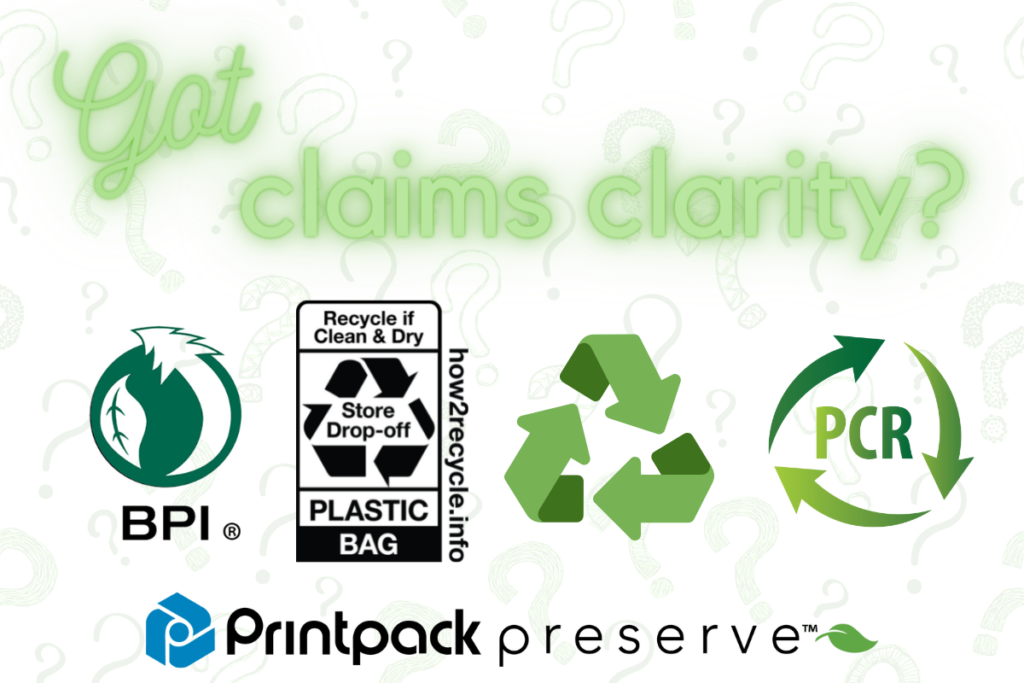As the demand for sustainable options grows, now is the time to review package designs and on-pack information to ensure that your brand is effectively communicating to consumers about your sustainable packaging.
Sustainability-marketed products delivered over half of CPG market growth in the past five years, which was 7x faster growth than products not marketed as sustainable. Further, this growth continues despite the COVID-19 pandemic. Clearly, consumers are interested in participating in the eco revolution and, with significantly lower price sensitivity to green-labeled products, they are willing to pay premium prices to play their part. Therefore, there is immense opportunity for brands with scale to capture growth.
Unclear labeling, inaccurate claims, inconsistent design, and inconvenient disposal methods make addressing end-of-life concerns and adopting responsible practices a challenge for consumers. With these problems in mind, here are some key considerations when navigating the complex world of sustainable packaging and communicating your sustainability practices with your consumers.
- Make it Actionable & Convenient for the Consumer
The most successful sustainable scenarios happen when the desired consumer behavior is attainable. For example, when responsible disposal is made easy for the consumer, they are empowered to fulfill their desire to adopt sustainable habits. They then continue to make these feel-good purchases. These habits rely on packaging that is designed and labeled for the chosen sustainability practice, along with access to reliable and convenient collection and/or drop-off methods. To consumers, immediately actionable solutions are communicated by familiar icons on pack, such as those available from How2Recycle.
Providing easy to understand on-pack instructions helps your consumers to participate with your brand’s intended end-of-life goal for a particular package. In order to make these options for disposal or reuse more “clear, memorable, and applicable,” The Recycling Partnership recommends placing directions where “you will have their attention long enough to process the multiple pieces of information and consider crafting messages in a way that makes it easier to absorb and recall.” Choosing the right on-pack messaging can be a brand’s chance to empower consumers and enable your packaging to work harder.
- Ensure Your Claims are Correct and Compliant
While strong on-pack sustainability claims can boost your brand’s reputation, communicating them inaccurately can instantly damage it. Knowing what language can be used for each type of sustainable package can save a brand from many unwanted repercussions.
Using untrue claims can significantly damage consumers’ trust in a brand, undermining its commitment and credibility. Misapplying common green claims can also spark a legal battle, as the FTC monitors environmental claims made by businesses. Lastly, if a mismarked product doesn’t fit into a certain recyclable category, its misuse can result in a larger strain on the environment and contaminated recycling streams.
These consequences can be easily avoided. The FTC’s Green Guides help brands learn how to comply with the law when they make environmental claims and what those claims mean. In order to boast powerful on-pack claims and recognizable icons, brands can also choose to earn certifications. A well-educated packaging partner is the most effective way to ensure consistency with these laws and boost consumer confidence.
- Use Logical and Consistent Design
Detailed information must be conveyed with visual simplicity. Consumers are typically too busy to pay close enough attention to do a thorough scan for responsible disposal information on a product. In order to create a design that immediately sends the correct message, focus on consistency.
Research from Printpack Product Development Engineer II, Valerie Smith, revealed that consumers are more likely to notice recycling labeling located in the bottom right corner on the back panel of packages than those located on the bottom panel. Furthermore, the eye-tracking study also confirmed that consumers looked for recycling information in this area more frequently and for longer. [i]
To create consistent labeling in your category’s market, identify where on-pack claims innately catch the consumer’s eye and evaluate peers who are also investing in responsible packaging. Whereas the goal is typically for brands to stand out and set themselves apart, this is an instance where efforts to follow suit will help consumers accurately and automatically know how to do the right thing.
With pre-approved How2Recycle packaging from Printpack, brands can provide consistent and transparent on-pack recycling information with a nationally recognized label. The expansion of its PRESERVE™ line of store drop-off, recyclable packaging solutions into the fresh produce market continues to make it easier for brands and consumers in more packaged food categories to recycle effectively. The standardized labeling system from How2Recycle is already proving to be a change agent, as 65% of consumers report changing their behaviors because of the How2Recycle labels.
Despite the advice to be consistent with competitors regarding the placement of sustainability claims, brands CAN differentiate themselves by creating a unique story with emotive messaging. This type of personal messaging can deepen connections with consumers by “appealing to what is already on someone’s mind, resonating with their values, or by being part of their circle.” Printpack provides expertly researched and knowledgeable market insights and can help you employ storytelling for your brand.
Consumers are looking for and even expecting brands to offer responsible packaging that is designed and labeled for circularity. Keeping these three objectives in mind, brands can drive incremental, but meaningful behavior changes by focusing on consistency and convenience for the consumer.
[i] Smith, Valerie, “Eye Tracking Recycle Labels on Packaging: Are Attitudes and Behaviors a Predictor of Viewing Them?” (2015). All Theses. Paper 2254.





